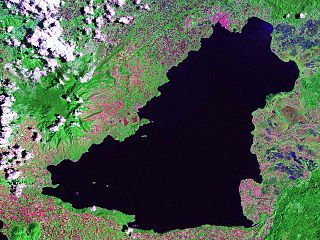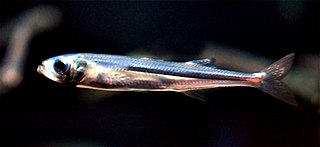
The Poeciliidae are a family of freshwater fishes of the order Cyprinodontiformes, the tooth-carps, and include well-known live-bearing aquarium fish, such as the guppy, molly, platy, and swordtail. The original distribution of the family was the Southeastern United States to north of Río de la Plata, Argentina, and Africa, including Madagascar. Due to release of aquarium specimens and the widespread use of species of the genera Poecilia and Gambusia for mosquito control, though, poeciliids can today be found in all tropical and subtropical areas of the world. In addition, Poecilia and Gambusia specimens have been identified in hot springs pools as far north as Banff, Alberta.

Lake Lanao is a large ancient lake in the Philippines, located in Lanao del Sur province in the country's southern island of Mindanao. With a surface area of 340 km2 (130 sq mi), it is the largest lake in Mindanao, and the second largest lake in the Philippines and counted as one of the 15 ancient lakes in the world. Scholars have been pushing for the lake's inclusion in the UNESCO World Heritage List.

Astroblepus is a genus of fish in the family Astroblepidae found in South America and Panama. This genus is the only member of its family. These catfishes are primarily found in torrential streams in the Andean area. Astroblepus pholeter and A. riberae are troglobites adapted to living in subterranean water systems. These species are typically small, less than 10 cm (4 in). The largest species reaches 30 cm (1 ft). These fish have suckermouths like those of loricariids. They have two pairs of barbels, maxillary and nasal. The dorsal fin spine lacks a locking mechanism. These fish also have odontodes, tiny teeth on their skin. All species exhibit a conical, pointy type on their fin rays like that found in other loricarioids; other species also exhibit a blunt type that is only found on their skin.

Farlowella is a genus of fish in the family Loricariidae native to South America. This genus is broadly distributed in Amazon, Orinoco, Paraná and coastal rivers of the Guyana Shield. It is absent from the Pacific slope of the Andes and from the coastal rivers of the Brazilian Shield. Many of these species are kept in aquarium. This genus has a unique body shape that resembles of a thin stick of wood. The body is slender and elongate, often with a pronounced rostrum and a brownish color with two lateral dark stripes beginning at the tip of the rostrum, passing over the eyes and ending at the tail, which are periodically interrupted on the caudal peduncle.

Barbodes is a genus of small to medium-sized cyprinid fish native to tropical Asia. The majority of the species are from Southeast Asia. Many species are threatened and some from the Philippines are already extinct. A survey carried out in 1992 only found three of the endemic Barbodes species, and only two were found in 2008. Several members of this genus were formerly included in Puntius.
Mercer's tusked silverside is a species of fish.

Mugilogobius is a genus of fish in the family Gobiidae. They are found in fresh, brackish and marine water of the Indo-Pacific region. Several of the freshwater species have highly restricted distributions.

Oryzias is a genus of ricefishes native to fresh and brackish water in east and south Asia. Some species are widespread and the Japanese rice fish is commonly used in science as a model organism, while others have very small ranges and are threatened. They are small, up to 8 cm (3.1 in) long, and most are relatively plain in colour.
Phallostethus dunckeri is a species of fish in the family Phallostethidae. It is endemic to Malaysia.
Phallostethus is a small genus of fishes in the family Phallostethidae native to freshwater and brackish habitats in southeast Asia.

Sicyopterus is a genus of gobies native fresh waters from Madagascar to the Pacific islands.
Pterocryptis is a genus of sheatfish. These fish are medium-sized catfishes usually found in fast flowing mountain streams throughout India, southern China and Southeast Asia. There are two cavefish species in the genus, P. buccata and P. cucphuongensis.

Phallostethidae, also known as the priapium fish, is a family of atheriniform fish native to freshwater and brackish habitats in southeast Asia.
Gulaphallus is a genus of fishes in the family Phallostethidae, native to the Philippines. They are mainly found in freshwater habitats, but G. panayensis is from brackish and marine habitats. It is the only genus in the subfamily Gulaphallinae.
Phenacostethus is a genus of fishes in the family Phallostethidae found in freshwater and brackish habitats in southeast Asia.
Patagonotothen is a genus of notothen native to the Southern Ocean.

Poeciliinae is a subfamily of killifish from the family Poeciliidae which contains species from the Americas which are collectively known as the livebearers because many, but not all, of the species within the subfamily are ovoviviparous.

Atherinoidei is a suborder of the order Atheriniformes comprising six families, with a mainly Old World distribution, although a few species are found in the western Atlantic Ocean.

Phallostethinae is a subfamily of fishes, one of two subfamilies in the family Phallostethidae, the priapumfishes. The species in this subfamily are characterised mainly by having highly protrusible jaws. The genus Neostethus appears to be the sister taxon to the other two genera in the subfamily. The species in the Phallostethinae are found in south-east Asia, the Malay Archipelago and the Philippines.











